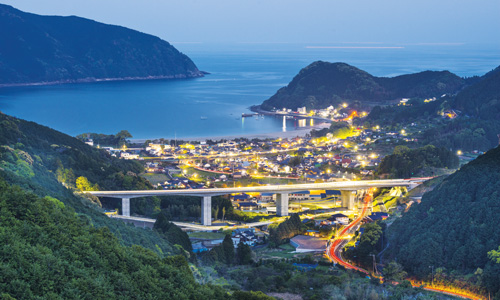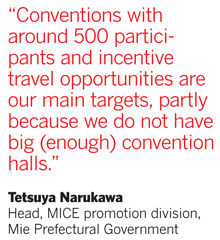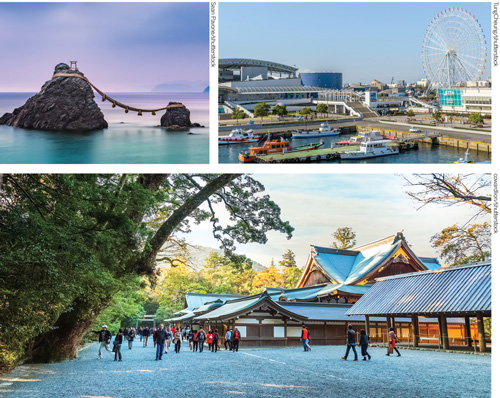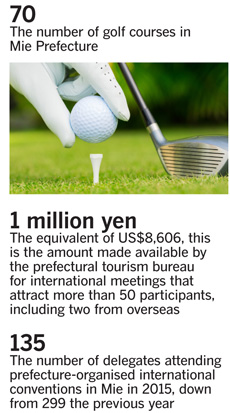
Clockwise from left: Meoto Iwa Rocks, Futami; The Port of Nagoya,
Ise Bay; Ise Grand Shrine
After the 2016 G-7 Summit put it on the international events radar, Mie now has its sights on small- to medium-sized groups. By Julian Ryall
Japan’s Mie Prefecture hosted just one international convention with a mere 135 participants in 2015, but a heavyweight conference held there the following year is igniting hope for a change in fortunes for its business events sector.
The world’s key leaders were present at the two-day G-7 Ise-Shima Summit in May 2016, bringing attention to a relatively unknown region of Japan, the birthplace of ninja, cultured pearls and unique traditional festivals.
This also raised the business events profile of the prefecture, and 10 major international events have already been scheduled for 2017.

“We consider the hosting of the G-7 Ise-Shima Summit to be the starting point for the Mie Prefectural Government to attract MICE events,” said Tetsuya Narukawa, head of the MICE promotion division of the local authority. “We intend to make the very most of this excellent opportunity.”
According to Narukawa, previously, local universities had been the only players in the prefecture’s events sector, hosting a handful of academic conferences each year.
“The prefecture set up the new MICE promotion division in April 2016 and is working with town and city governments throughout the prefecture to win new business,” he said.
He elaborated: “Conventions with around 500 participants and incentive travel opportunities are our main targets, partly because we do not at present have big convention halls that can accommodate thousands of people.”
Narukawa added that the division will start by focusing on conventions in the fields of history, culture, entertainment, marine issues and food.
The city of Tsu is scheduled to open the Sacrena arena in October 2017, with the main facility covering more than 3,000m2 with capacity for 4,000 people. A smaller arena will cover more than 1,700m2 and be able to hold 490 people. The city of Shima is due to complete renovations of the Ago Arena, to handle 1,700 people, in March 2018.
The prefectural government has no plans at present to construct new venues, although a number of initiatives are underway.
“We do not have the advantage of MICE infrastructure that exists in other prefectures, so we are focusing on providing useful information to (organisers and) anyone planning on coming to Mie for an event, such as on hotels, subsidy programmes, unique venues, local entertainment and so on,” said Narukawa.
The G-7 summit did however prompt some hardware upgrades. The Shima Kanko Hotel hosted the G-7 talks, and leading up to that carried out a major overhaul of its facilities.
The largest conference room in the hotel covers 555m2, while the hotel’s other properties in the district also have a selection of meeting facilities, in addition to lounges, cafes, wine bars and other event venues.
“Since the G-7 summit, the number of fam trips to Mie has increased sharply, so the prefecture is hoping very much to attract both more international tourists as well as MICE events,” said Yukimitsu Nakanishi, head of sales for the hotel.
In an average year, the hotel hosts three major events and Nakanishi hopes that the G-7 summit will have put Mie more firmly on the business events map.
“Now, we are looking to cooperate more closely with the prefecture and the Japan National Tourism Organization to promote this destination, as well as to encourage travel agents to work with organisers of travel conventions,” Nakanishi added.
Another property that is hoping to reap new business event opportunities is the Ise Shima Royal Hotel.
“We feel that we are getting more attention than before, but I cannot say that it has been reflected in our numbers yet,” Sanae Mukohara, general manager of the hotel, said.
To date, the majority of business events at the hotel each year have been corporate incentive functions, with as many as 500 guests attending a larger event.
Mukohara believes there are solid opportunities in the sector in the future.
“We are currently working on improving the Engligh version of our official website. We are also planning to strengthen our connections with other facilities and local governments in our area and take part in international MICE events,” she added.

Atashika waterfront in Kumano city
{Talking numbers}

{Developments to Watch}
![]() Japan’s Ministry of Land, Infrastructure, Transport and Tourism will start providing low-interest loans for the construction of convention centres in cities that presently lack such facilities in an effort to meet growing demand. To qualify, projects must be for facilities that cover at least one hectare or have meeting space of at least 1,000m2. The ministry will provide loans of up to half of the total cost of any new convention centre for up to 20 years.
Japan’s Ministry of Land, Infrastructure, Transport and Tourism will start providing low-interest loans for the construction of convention centres in cities that presently lack such facilities in an effort to meet growing demand. To qualify, projects must be for facilities that cover at least one hectare or have meeting space of at least 1,000m2. The ministry will provide loans of up to half of the total cost of any new convention centre for up to 20 years.
![]() The Japan Tourism Agency has established a cross-ministry commitee before the end of 2016 to consider ways of attracting a greater number of international conferences to Japan. The initiative follows in the footsteps of Tokyo, which created its own strategy in July 2015 and has set a target to host 50 per cent more MICE events in 2024 than in 2014.
The Japan Tourism Agency has established a cross-ministry commitee before the end of 2016 to consider ways of attracting a greater number of international conferences to Japan. The initiative follows in the footsteps of Tokyo, which created its own strategy in July 2015 and has set a target to host 50 per cent more MICE events in 2024 than in 2014.
![]() The government has set aside a record budget of over 24.5 billion yen (US$21.1 million) for the tourism sector for fiscal 2017, 2.36 times the figure for the prevous year. Of that total, 9.48 billion yen is going into strategic promotions for inbound markets to attract MICE to Japan.
The government has set aside a record budget of over 24.5 billion yen (US$21.1 million) for the tourism sector for fiscal 2017, 2.36 times the figure for the prevous year. Of that total, 9.48 billion yen is going into strategic promotions for inbound markets to attract MICE to Japan.






















